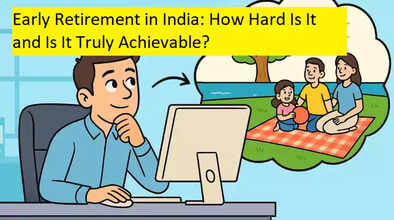Early Retirement in India: How Hard Is It and Is It Truly Achievable?

Early retirement is a growing dream among young professionals in India, but achieving it is far from easy. Rising costs, inflation, and long life expectancy make it a challenging goal. Here’s a detailed look at the hurdles and possible alternatives.
Why Early Retirement Appeals
The desire to retire early, often by 40 or 45, is influenced by the global FIRE movement (Financial Independence, Retire Early). Young Indians increasingly want to spend their time traveling, pursuing hobbies, or being with family rather than being tied to a traditional 9-to-5 job.
Factors driving this trend include:
-
Changing priorities: Unlike previous generations, today’s youth value freedom and flexibility over job security.
-
Social media influence: Financial influencers and platforms popularize the FIRE philosophy.
-
Stress and burnout: High-pressure jobs and long work hours in metro cities push professionals to seek early exit options.
-
Growing discussions: Conversations around financial independence and early retirement have become mainstream.
The Numbers Behind Retiring at 40
Assume you’re 25 and plan to retire at 40, with current monthly expenses of ₹1 lakh. Accounting for inflation, these expenses could rise to ₹2–2.4 lakh per month within 15 years, totaling ₹25–30 lakh annually. To maintain this lifestyle for another 40 years without earning, you’d need a corpus of around ₹7–8 crore, assuming a safe withdrawal rate of 4–5% annually.
Achieving this requires investing ₹1.5–2 lakh monthly from age 25 at an annual return of 12%. For most, EMIs, rent, and family obligations make this nearly impossible.
Practical Alternatives to Full Early Retirement
While retiring at 40 may be unrealistic for many, there are ways to reduce work pressure and enjoy life:
-
Mini-Retirement: Take extended breaks (6–12 months) every few years to travel, study, or pursue hobbies.
-
Coast FIRE: Save aggressively in your 20s and 30s, then sustain with part-time or low-intensity work later.
-
Flexible Retirement: Retire at 50–55 with alternative income sources like rentals, dividends, or consulting.
-
Hybrid Plan: Cut unnecessary expenses, relocate to smaller cities, or take up freelancing/part-time work to grow savings.
-
Career Rebalancing: Opt for lower-stress jobs in your 30s, even if the pay is slightly lower.
-
Health-First Retirement: Focus on work-life balance and health if burnout is the main reason for wanting early retirement.
Bottom Line
The idea of retiring at 40 is exciting but practically very challenging. Rising costs, extended life expectancy, and lifestyle expectations make it a tough target for most. A more realistic approach is to aim for financial independence, skill growth, and a balanced lifestyle, which allows enjoyment of life without compromising financial security or personal happiness.

